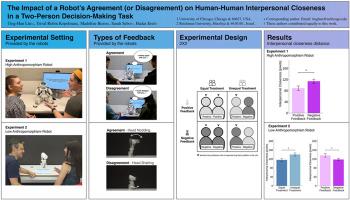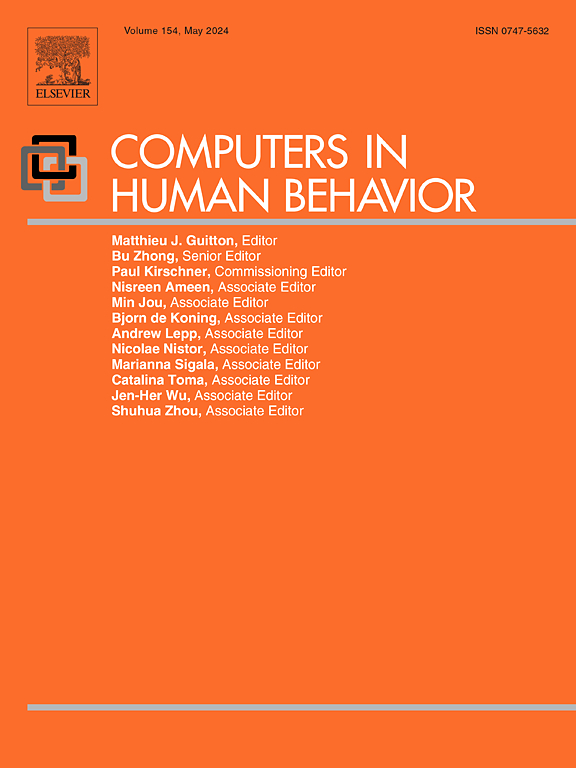在两人决策任务中,机器人的同意(或不同意)对人与人之间的亲密关系的影响
IF 8.9
1区 心理学
Q1 PSYCHOLOGY, EXPERIMENTAL
引用次数: 0
摘要
机器人和人工智能正越来越多地融入我们的生活,并有望帮助人们做出决策。尽管机器人辅助决策系统具有优势,但它可能对人类团队成员之间的关系产生负面影响。在这项工作中,我们研究了机器人的同意(或不同意)对两人决策任务中两个参与者之间的人际亲密度的影响。实验1 (N = 172,86对)采用高拟人化机器人,实验2 (N = 150,75对)采用低拟人化机器人。在这两个实验中,我们使用2 x 2的研究设计来检验两个参与者之间感知到的人际亲密度如何受到机器人行为的两个方面的影响,即机器人反馈的效价(积极反馈或消极反馈)和两个参与者的待遇(平等待遇或不平等待遇)。我们的研究结果表明,当机器人提供积极的反馈而不是消极的反馈时,与高度拟人化机器人的互动会导致参与者之间更大的人际关系亲密。低拟人化机器人有不同的和相反的效果:当机器人的反馈是平等的而不是不平等的,当机器人提供负面反馈而不是积极反馈时,与这个机器人的互动会导致更大的人际关系亲密。我们的研究结果表明,当机器人在两人决策任务中表明它们与人的观点一致时,机器人可以塑造人与人之间的关系,并且机器人的影响力取决于它的外观和沟通方式。本文章由计算机程序翻译,如有差异,请以英文原文为准。

The impact of a robot's agreement (or disagreement) on human-human interpersonal closeness in a two-person decision-making task
Robots and artificial agents are becoming increasingly integrated into our lives and show promise in assisting people in decision-making tasks. Despite their advantages, robot-assisted decision-making systems may have negative effects on the relationships between human team members. In this work, we examine the influence of the robot's agreement (or disagreement) on the interpersonal closeness between two participants in a two-person decision-making task. We test the robot's impact in two experiments: Experiment 1 (N = 172, 86 pairs) with a High Anthropomorphism Robot and Experiment 2 (N = 150, 75 pairs) with a Low Anthropomorphism Robot. For both experiments, we use a 2 x 2 study design to examine how the perceived interpersonal closeness between two participants was influenced by two aspects of robot behavior, namely the valence of the robot's feedback (positive feedback or negative feedback) and the treatment of the two participants (equal treatment or unequal treatment). Our results demonstrate that interacting with the High Anthropomorphism Robot led to greater interpersonal closeness between participants when the robot provided positive feedback as opposed to negative feedback. The Low Anthropomorphism Robot had a different and opposite effect: interactions with this robot led to greater interpersonal closeness when the robot's feedback was equal as opposed to unequal and when the robot provided negative feedback as opposed to positive feedback. Our results indicate that robots can shape human-human relationships when indicating their agreement with people's perspectives in two-person decision-making tasks and that the robot's influence depends on its appearance and communication style.
求助全文
通过发布文献求助,成功后即可免费获取论文全文。
去求助
来源期刊

Computers in Human Behavior
Multiple-
CiteScore
19.10
自引率
4.00%
发文量
381
审稿时长
40 days
期刊介绍:
Computers in Human Behavior is a scholarly journal that explores the psychological aspects of computer use. It covers original theoretical works, research reports, literature reviews, and software and book reviews. The journal examines both the use of computers in psychology, psychiatry, and related fields, and the psychological impact of computer use on individuals, groups, and society. Articles discuss topics such as professional practice, training, research, human development, learning, cognition, personality, and social interactions. It focuses on human interactions with computers, considering the computer as a medium through which human behaviors are shaped and expressed. Professionals interested in the psychological aspects of computer use will find this journal valuable, even with limited knowledge of computers.
 求助内容:
求助内容: 应助结果提醒方式:
应助结果提醒方式:


